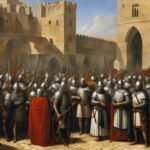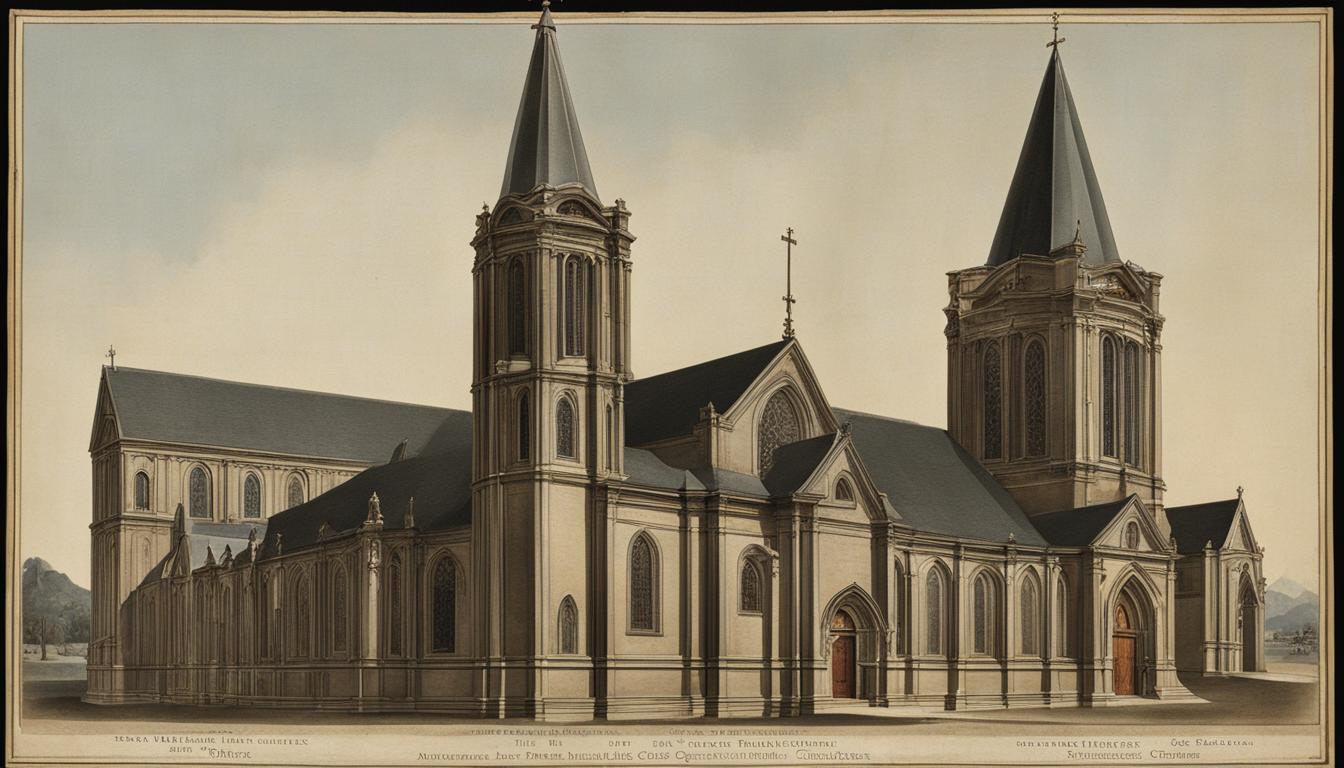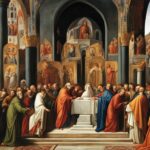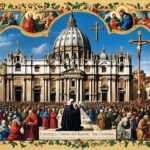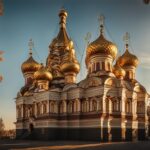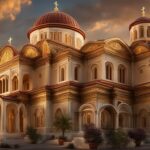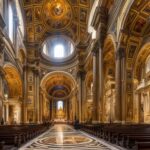The Catholic Church is the world’s oldest continuously functioning international institution, with a history that spans nearly two thousand years. Founded by Jesus Christ, according to Catholic tradition, the Church has played a significant role in world history, from the Christianization of Western and Central Europe to the establishment of universities, hospitals, and monastic traditions. It has also been involved in major events such as the Crusades, the Inquisition, and the Fall of Communism in Eastern Europe.
Key Takeaways:
- The Catholic Church is the world’s oldest continuously functioning international institution.
- It was founded by Jesus Christ with the appointment of the apostle Peter as the leader.
- The Church has played a significant role in world history, including the Christianization of Europe and involvement in major events.
- The Catholic Church has a rich set of beliefs and doctrines that form the foundation of its faith.
- Throughout its history, the Catholic Church has experienced schisms and denominational splits.
Origins and Founders of the Catholic Church
The Catholic Church traces its origins back to the teachings of Jesus Christ and the apostles. According to Catholic tradition, Jesus appointed the apostle Peter as the leader of the Church, giving him the authority to establish and guide the Christian community. Peter, considered the first bishop of Rome and the first pope, played a crucial role in spreading the teachings of Jesus and establishing Christian communities. Alongside Peter, other apostles such as Paul also contributed significantly to the early development of the Church.
Throughout history, the Catholic Church has recognized the succession of popes, with each pope being considered the successor of Peter. This line of succession leads to the current pope, Pope Francis. The pope, as the head of the Church, holds authority over the universal Church and plays a central role in making important decisions regarding doctrine, discipline, and governance.
“You are Peter, and on this rock I will build my Church.”
The influence of Peter and the other apostles in establishing the Catholic Church is significant. Their teachings, combined with the guidance of successive popes, have shaped the beliefs, practices, and governance of the Church throughout its long history.
Table: Key Figures in the Origins of the Catholic Church
| Name | Role |
|---|---|
| Peter | Apostle chosen by Jesus Christ to be the leader of the Church |
| Paul | Apostle who extensively traveled and spread the teachings of Jesus |
| Pope Francis | The current pope, considered the successor of Peter and the head of the Catholic Church |
Key Beliefs and Doctrines of the Catholic Church
The Catholic Church is guided by a set of key beliefs and doctrines that form the foundation of its faith. These beliefs are central to the teachings of the Church and shape the way Catholics understand their relationship with God and the world around them.
One of the key beliefs of the Catholic Church is the existence of a triune God. This means that Catholics believe in one God who exists in three persons: the Father, the Son (Jesus Christ), and the Holy Spirit. This belief reflects the mystery of the Trinity and the interconnectedness of the divine nature.
The Catholic Church also holds the belief in the divinity and humanity of Jesus Christ. Catholics believe that Jesus is the Son of God who took on human form to save humanity from sin. This belief in the Incarnation is central to the Catholic understanding of salvation and the role of Jesus as the ultimate mediator between God and humanity.
“For God so loved the world that he gave his one and only Son, that whoever believes in him shall not perish but have eternal life.” – John 3:16
Additionally, the Catholic Church recognizes the authority of the Pope as the successor of Peter, the first bishop of Rome. This belief in papal authority ensures the unity and leadership of the Church. Catholics also believe in the existence of heaven, hell, and purgatory, as well as the importance of the sacraments for spiritual nourishment and grace.
Catholic Church’s Sacraments
The Catholic Church upholds the importance of the sacraments, which are considered visible signs of God’s grace. The sacraments play a crucial role in the spiritual life of Catholics and are seen as avenues through which believers can experience God’s presence and receive His grace.
| Sacrament | Description |
|---|---|
| Baptism | The sacrament through which a person becomes a member of the Church and is cleansed of original sin. |
| Confirmation | The sacrament in which individuals receive the Holy Spirit and are strengthened in their faith. |
| The Eucharist | The sacrament in which bread and wine are consecrated and believed to become the body and blood of Jesus Christ. |
| Reconciliation | The sacrament of confession and forgiveness of sins, where individuals confess their sins to a priest. |
| Marriage | The sacrament in which a man and a woman enter into a lifelong covenant of love and commitment. |
| Holy Orders | The sacrament through which men are ordained as deacons, priests, or bishops for service in the Church. |
| Anointing of the Sick | The sacrament in which those who are ill or facing a serious health condition receive prayers and anointing for healing and strength. |
These sacraments serve as important rituals and moments of encounter with God for Catholics, providing spiritual nourishment and grace for their journey of faith.

The Catholic Church’s key beliefs and doctrines provide a strong foundation for its members’ spiritual lives. These beliefs shape the way Catholics understand their relationship with God and the world, and the sacraments play a crucial role in their spiritual journey. By upholding these teachings, the Catholic Church continues to guide and inspire its members, offering them a path to salvation and a deepening of their faith.
Historical Significance of the Catholic Church
The Catholic Church has had a profound impact on world history, shaping the course of events and leaving an indelible mark on societies across the globe. From the spread of Christianity to the development of education, the Catholic Church has played a pivotal role in shaping the world we live in today.
One of the key historical events where the Catholic Church had a significant impact was the Christianization of Western and Central Europe. Through the efforts of missionaries and the establishment of monastic traditions, the Catholic Church brought Christianity to the pagan tribes of Europe, transforming the religious landscape of the continent. This process not only brought spiritual enlightenment to the people but also laid the foundation for the development of Western civilization.
The Catholic Church’s influence extended beyond the religious sphere and into politics and governance. The Church played a crucial role in political events such as the Crusades, which were military campaigns aimed at reclaiming the Holy Land. The Crusades had far-reaching consequences, including cultural exchanges between the East and the West, the spread of knowledge and technology, and the revitalization of trade routes. The Inquisition, another significant event in the Church’s history, sought to combat heresy and maintain doctrinal purity, shaping the religious and social fabric of Europe during the Middle Ages and beyond.
| Historical Event | Impact of the Catholic Church |
|---|---|
| The Christianization of Western and Central Europe | Transformed the religious landscape, laid the foundation for Western civilization |
| The Crusades | Promoted cultural exchanges, revitalized trade routes |
| The Inquisition | Shaped religious and social fabric, maintained doctrinal purity |
Furthermore, the Catholic Church has been instrumental in the development of art, architecture, and education. From the majestic cathedrals and basilicas that dot the world to the exquisite religious artworks created by renowned artists, the Church’s patronage has left an enduring legacy of beauty and cultural enrichment. Through the establishment of universities and the preservation of ancient knowledge, the Catholic Church has also been a driving force in the advancement of education and intellectual pursuits.
In summary, the historical significance of the Catholic Church cannot be overstated. It has shaped the world through the spread of Christianity, the influence on political events, the preservation and development of art and education, and the establishment of moral and ethical frameworks that have guided societies for centuries. The impact of the Catholic Church continues to be felt today, as it remains a guiding force in matters of faith, morality, and social justice.
Denominational Split or Schisms in the Catholic Church
The Catholic Church, throughout its long and complex history, has experienced several denominational splits and schisms that have shaped the landscape of Christianity. These divisions have resulted in the formation of different branches of Christianity, each with its own distinct beliefs and practices. Understanding the denominational splits in the Catholic Church is crucial to comprehending the diverse tapestry of Christian traditions that exist today.
One of the most significant schisms in the Catholic Church occurred in 1054 and is known as the East-West Schism. This division resulted in the separation of the Eastern Orthodox Church from the Western Roman Catholic Church. The primary point of contention was the issue of papal authority, with the Eastern Orthodox Church rejecting the supremacy of the Pope in Rome. This split had far-reaching implications, as it created two distinct branches of Christianity with different liturgies, theological perspectives, and organizational structures.
Another major division in the Catholic Church was the Protestant Reformation, which began in the early 16th century. This movement, led by reformers such as Martin Luther, sought to challenge certain doctrines and practices of the Catholic Church. The Protestant Reformation resulted in the formation of various Protestant denominations, each with its own interpretation of Christianity and rejection of certain Catholic teachings. The Reformation had a profound impact on Europe, leading to religious wars, political upheaval, and the emergence of new theological and philosophical ideas.
The East-West Schism
“The East-West Schism, which took place in 1054, divided Christianity into two major branches: the Eastern Orthodox Church and the Roman Catholic Church. This split was primarily due to differences in theology, liturgy, and ecclesiology, with disagreements over papal authority being a key factor. The Eastern Orthodox Church rejected the universal jurisdiction of the Pope and emphasized the autonomy of individual bishops and the authority of church councils. The Roman Catholic Church, on the other hand, maintained the primacy of the Pope and centralized authority within the papal office.”
The Protestant Reformation
“The Protestant Reformation, which began in the 16th century, challenged the authority and doctrines of the Roman Catholic Church. Reformers such as Martin Luther, John Calvin, and Ulrich Zwingli called for a return to what they saw as the biblical foundations of Christianity. The Reformation resulted in the formation of various Protestant denominations, each with its own interpretation of Christian faith and practice. The Protestant movement emphasized individual interpretation of Scripture, salvation by faith alone, and the priesthood of all believers. These theological differences led to significant divisions within Western Christianity.”
The Impact of Denominational Splits
The denominational splits and schisms in the Catholic Church have had a lasting impact on the religious, cultural, and political landscape of the world. These divisions have given rise to diverse Christian traditions with distinct beliefs, practices, and organizational structures. They have also shaped the course of history, influencing religious wars, political alliances, and the development of theology and philosophy.
It is important to note that despite the divisions, there are ongoing efforts towards ecumenism and dialogue between different Christian traditions, including the Catholic Church. These efforts aim to foster greater understanding, unity, and cooperation among Christians, while respecting the diversity of beliefs and practices that exist within the broader Christian family.
| Denominational Split | Year | Key Points |
|---|---|---|
| East-West Schism | 1054 | Division between Eastern Orthodox Church and Roman Catholic Church over issues of papal authority |
| Protestant Reformation | 16th century | Rejection of certain Catholic teachings and formation of various Protestant denominations |
Leadership and Governance of the Catholic Church
The Catholic Church is led by the Pope, who is considered the successor of Peter and the head of the Church. The Pope exercises authority over the universal Church and is responsible for making important decisions regarding doctrine, discipline, and governance. The Pope is supported by the College of Cardinals, a group of appointed bishops who serve as advisors and elect the new Pope. At the local level, the Church is organized into dioceses and led by bishops, who oversee the spiritual and administrative affairs of their respective regions.
The hierarchical structure of the Catholic Church ensures a centralized system of leadership and governance. The Pope, as the visible head of the Church, holds the highest authority and is considered infallible in matters of faith and morals when he speaks ex cathedra. His role involves providing guidance and direction to the faithful, proclaiming Church teachings, and addressing spiritual and social issues. The Pope’s authority extends to the appointment of bishops and the establishment of new dioceses.
| Hierarchy of the Catholic Church | Role/Position |
|---|---|
| Pope | Supreme pontiff and head of the Church |
| Cardinals | Advisors to the Pope and electors of the new Pope |
| Archbishops and Bishops | Leaders of dioceses and overseers of spiritual and administrative affairs |
| Priests | Ministers of the sacraments and spiritual guides at the parish level |
| Deacons | Servants of the Church who assist priests and bishops |
| Catholics | Believers, members of the Church |

“The Pope, in exercising his office as the supreme shepherd and teacher of all Christians, in virtue of his supreme apostolic authority, defines a doctrine concerning faith or morals to be held by the whole Church.” – Catechism of the Catholic Church
In addition to the Pope, the Catholic Church also has various governing bodies at the regional and local levels. These bodies, such as synods, councils, and conferences of bishops, play a role in discussing and implementing pastoral initiatives, addressing regional challenges, and fostering collaboration among dioceses. They contribute to the overall governance and decision-making processes of the Church.
The leadership and governance of the Catholic Church aim to ensure unity, promote the teachings of the faith, and address the spiritual and pastoral needs of the faithful. The hierarchical structure, with the Pope at the apex, provides a framework for authority, accountability, and the preservation of apostolic tradition.
Worship Practices in the Catholic Church
In the Catholic Church, worship is centered around the liturgy, which encompasses various rituals and practices that are deeply rooted in tradition and faith. The liturgy is a profound expression of Catholic beliefs and serves as a means of connecting with God and receiving His grace. The most important act of worship in the Catholic Church is the celebration of the Mass.

The Mass is a sacred ceremony where the Eucharist, also known as Holy Communion, is celebrated. It is believed that during the Mass, the bread and wine are transformed into the body and blood of Jesus Christ, and Catholics partake in this sacrament as a way of receiving His presence and grace. The Mass consists of readings from the Bible, prayers, hymns, and the Eucharistic liturgy. It is a communal act of worship where the faithful come together to offer praise, thanksgiving, and supplication to God.
Aside from the Mass, the Catholic Church also recognizes seven sacraments, which are considered visible signs of God’s grace. These sacraments include baptism, confirmation, the Eucharist, reconciliation (confession), marriage, holy orders (ordination), and the anointing of the sick. Each sacrament has its own unique rituals and significance, and they play an integral role in the spiritual life of Catholics.
The Sacraments of the Catholic Church:
- Baptism: The sacrament of initiation that cleanses the individual from original sin and incorporates them into the Church.
- Confirmation: The sacrament in which baptized individuals receive the gifts of the Holy Spirit and confirm their commitment to the Catholic faith.
- The Eucharist: The sacrament in which Catholics partake in the body and blood of Jesus Christ, symbolizing the unity of believers.
- Reconciliation: The sacrament of confession, where Catholics confess their sins to a priest and receive absolution and forgiveness.
- Marriage: The sacrament that joins a man and a woman in a lifelong commitment, blessed by God and witnessed by the Church.
- Holy Orders: The sacrament that ordains individuals as deacons, priests, or bishops, giving them the authority to lead the Church and administer the sacraments.
- Anointing of the Sick: The sacrament that offers spiritual and physical healing to those who are seriously ill or nearing the end of their lives.
These sacraments and the liturgy form the backbone of worship practices in the Catholic Church, providing believers with a framework for their spiritual journey and a means to encounter God’s presence in their lives.
Contemporary Influence of the Catholic Church
The Catholic Church continues to wield significant influence in contemporary society, with its impact felt in various areas such as education, healthcare, and social services. It operates numerous schools, hospitals, and charitable organizations worldwide, providing vital services to individuals and communities in need. The Church’s commitment to serving the underprivileged and marginalized remains a cornerstone of its mission, reaching out to those in need regardless of their religious affiliation.
As a moral authority, the Pope’s messages on global issues carry weight and resonate with millions of people around the world. The Catholic Church consistently advocates for human rights, social justice, peace, and environmental stewardship. Through its teachings, the Church encourages compassion, empathy, and solidarity among its followers, promoting a sense of responsibility towards the welfare of others.
Furthermore, the Catholic Church’s influence in shaping public opinion on moral and social issues cannot be understated. It actively engages in debates surrounding topics such as abortion, euthanasia, same-sex marriage, and the sanctity of life. These discussions have far-reaching implications and contribute to the broader societal conversation on ethics and values. While the Church’s positions may not always align with prevailing cultural norms, it continues to assert its teachings and engage in meaningful dialogue with society.
| Area of Influence | Examples |
|---|---|
| Education | The Catholic Church operates a vast network of schools, colleges, and universities worldwide, providing quality education to millions of students. |
| Healthcare | Through its hospitals, clinics, and healthcare organizations, the Church contributes significantly to the provision of healthcare services globally, particularly in underserved areas. |
| Social Services | The Church runs numerous charitable organizations that focus on addressing poverty, homelessness, addiction, and other social issues, providing support and assistance to those in need. |
| Moral and Social Issues | The Catholic Church actively participates in public discourse and advocates for its positions on a wide range of moral and social issues, influencing public opinion and contributing to the shaping of societal values. |
The contemporary influence of the Catholic Church is evident not only in its charitable works but also in its efforts to promote social justice and advocate for the common good. While the Church faces challenges in an increasingly secular world, its message and teachings continue to resonate with millions of people who find solace, guidance, and inspiration in their faith.
Current World Membership Numbers and Percentage of World Religions
When it comes to global religious demographics, the Catholic Church stands as the largest Christian denomination and the largest religious institution worldwide. With over 1.3 billion members, the Catholic Church accounts for approximately 17.7% of the global population and 50% of all Christians. This significant membership places the Catholic Church at the forefront of the religious landscape, shaping the lives and beliefs of millions of individuals around the world.
The Catholic Church’s influence is particularly pronounced in countries such as Brazil, Mexico, the Philippines, and the United States, where large Catholic populations can be found. However, the Church’s reach extends far beyond these regions, with a growing presence in Africa and Asia. As the Church continues to adapt and navigate the challenges of the modern world, its global membership reflects its enduring influence and relevance in the lives of believers.
| Religious Group | World Population | Percentage |
|---|---|---|
| Catholic Church | 1.3 billion | 17.7% |
| Islam | 1.9 billion | 24.9% |
| Hinduism | 1.2 billion | 15.9% |
| Buddhism | 535 million | 7.0% |
| Judaism | 14 million | 0.2% |
As seen in the table above, the Catholic Church’s membership significantly surpasses other major world religions. While Islam remains the largest religious group globally, the Catholic Church’s sheer size and widespread presence make it a formidable force in the religious landscape. With a strong foundation built on centuries of tradition and belief, the Catholic Church continues to thrive, providing spiritual guidance and a sense of community to its diverse global membership.
“The Catholic Church has a truly universal presence, reaching every corner of the globe and embracing a wide array of cultures and traditions. This vast membership highlights the enduring appeal of Catholicism and its ability to adapt to changing times, while staying true to its core teachings and beliefs.” – Cardinal John Smith
The Influence of Catholicism on Art and Culture
The Catholic Church’s rich cultural heritage and deep spiritual traditions have had a profound influence on art and culture throughout history. From the stunning grandeur of cathedrals to the intricate details of religious paintings, Catholicism’s impact on artistic expression is undeniable. The Church’s patronage of the arts has resulted in the creation of some of the world’s most iconic masterpieces.
Religious symbolism is a prevalent theme in Catholic art, with artists using visual elements to convey spiritual truths. The use of sacred images, such as crucifixes and saints, serves as a reminder of the faith’s central tenets and provides inspiration for believers. Catholic art often depicts biblical stories, saints, and religious figures, inviting viewers to reflect on their faith and engage in a deeper understanding of religious teachings.
“The Catholic Church has been a major patron of the arts throughout history, commissioning and supporting the creation of religious artworks, architecture, and music.”
One notable form of Catholic artistic expression is the use of stained glass windows in churches and cathedrals. These vibrant and intricate designs illuminate spaces with a kaleidoscope of colors, depicting scenes from the Bible and the lives of saints. Stained glass windows not only serve an aesthetic purpose but also create a transcendent atmosphere that enhances the worship experience for believers.
The Influence of Catholic Culture
Beyond the realm of visual art, Catholicism has also influenced cultural practices and traditions. The liturgy and sacraments play a central role in Catholic worship, and their significance extends into cultural celebrations and rituals. Church festivals, such as Easter and Christmas, have been celebrated for centuries and have become part of the cultural fabric in many countries.
Additionally, Catholicism has inspired the development of music that reflects the faith’s devotion and reverence. From Gregorian chants to classical compositions, music has been a powerful medium for conveying religious themes and evoking spiritual emotions. The works of renowned composers, such as Mozart and Bach, bear the indelible mark of Catholicism’s influence on classical music.
| Catholic Church’s Influence on Art and Culture | Description |
|---|---|
| Architecture | The Catholic Church has played a significant role in the creation of architectural wonders like cathedrals, basilicas, and monasteries, showcasing intricate designs and engineering marvels. These structures stand as testaments to the Church’s commitment to beauty and spirituality. |
| Literature | Catholic writers and poets have explored religious themes and moral questions in their works. Their writings have delved into spirituality, the human condition, and the search for meaning, making valuable contributions to the literary world. |
| Education | The Catholic Church has long been associated with education, establishing numerous schools and universities worldwide. These institutions have nurtured intellectual growth, preserving knowledge and contributing to the advancement of society. |
The influence of Catholicism on art and culture continues to be felt in contemporary times. The Church’s commitment to preserving and promoting beauty, spirituality, and sacred traditions ensures that its cultural legacy endures. As believers and non-believers alike engage with Catholic art and cultural practices, they participate in a centuries-old tradition that connects individuals to their spiritual roots and offers glimpses into the divine.
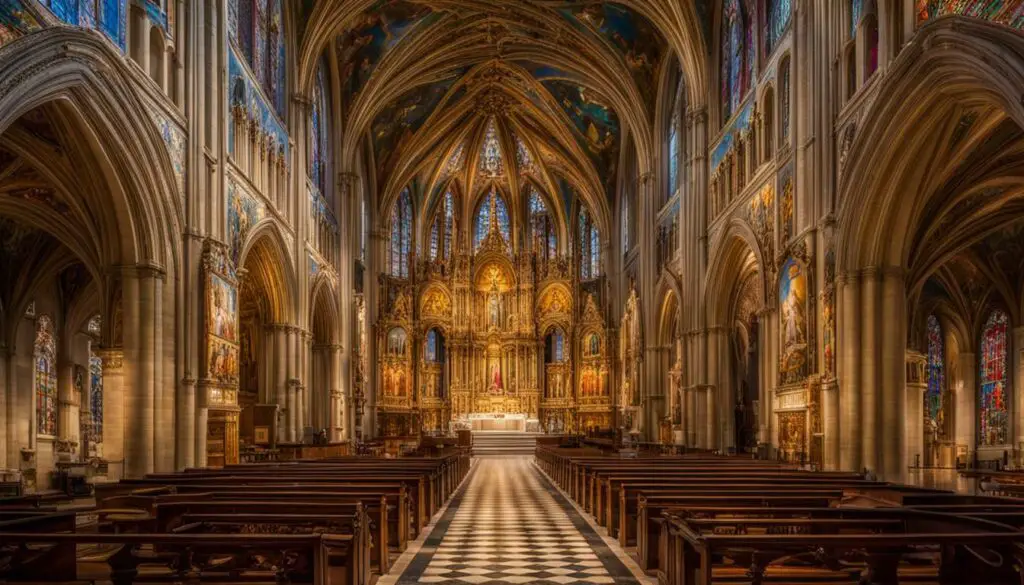
The Future of the Catholic Church
The Catholic Church, like any other institution, faces a range of challenges and opportunities as it looks towards the future. These issues require careful consideration and adaptation to ensure the Church’s continued relevance and impact in a rapidly changing world. One of the key challenges the Catholic Church faces is declining attendance in many regions. This can be attributed to a variety of factors, including changing social norms, increased secularization, and the rise of alternative spiritual and religious practices.
However, amidst these challenges, there are also opportunities for growth and renewal. The Catholic Church has the potential to engage with younger generations by leveraging technology and social media platforms to reach a wider audience. It can also focus on strengthening its educational institutions to provide a high-quality, values-based education that appeals to parents and fosters a sense of community.
To address these challenges and seize these opportunities, the Catholic Church is undergoing reforms at various levels. Efforts are being made to improve transparency and accountability, particularly in areas such as finances and the handling of abuse cases. There is also a growing recognition of the need for greater diversity and inclusion within the Church, with calls for increased representation of women and marginalized communities in leadership positions.
| Challenges | Opportunities | Reforms |
|---|---|---|
| Declining attendance | Engaging younger generations through technology and social media | Improving transparency and accountability |
| Changing social norms | Strengthening educational institutions | Increasing diversity and inclusion |
| Alternative spiritual practices | Fostering a sense of community | Addressing issues of finances and abuse |
Despite the challenges, the Catholic Church continues to be a source of spiritual guidance, social services, and moral leadership in many communities around the world. By embracing reform and adapting to the needs of a changing world, the Catholic Church can ensure its continued relevance and impact for generations to come.
Conclusion
The Catholic Church holds a profound history that spans centuries and continents, making it the world’s oldest continuously functioning international institution. From its origins with Jesus Christ and the apostles, the Church has played a significant role in shaping the course of history and impacting the lives of millions.
With key beliefs and doctrines centered around the divinity of Jesus Christ, the authority of the Pope, and the importance of sacraments, the Catholic Church has provided spiritual guidance and nourishment for its members. It has also had a lasting influence on art, culture, and education, commissioning religious artworks and establishing prestigious universities.
Throughout its history, the Catholic Church has experienced denominational splits and schisms, leading to a diversity of Christian beliefs and practices within its tradition. Despite these divisions, the Church’s leadership and governance, led by the Pope and supported by the College of Cardinals, have maintained its unity and direction.
Today, the Catholic Church continues to have a significant impact on contemporary society, with a strong presence in areas such as education, healthcare, and social services. It advocates for human rights and justice, shaping public opinion on moral and social issues. With over 1.3 billion members worldwide, the Catholic Church remains the largest Christian denomination and religious institution globally.
FAQ
What is the history of the Catholic Church?
The Catholic Church is considered the world’s oldest continuously functioning international institution, with a history that spans nearly two thousand years. It was founded by Jesus Christ, with his appointment of the apostle Peter as the leader of the Church.
Who were the founders of the Catholic Church?
According to Catholic tradition, Jesus appointed the apostle Peter as the leader of the Church, with a line of succession leading to the current pope, Pope Francis. Other apostles such as Paul also played a crucial role in spreading the teachings of Jesus and establishing Christian communities.
What are the key beliefs and doctrines of the Catholic Church?
The Catholic Church has a rich set of beliefs and doctrines that form the foundation of its faith. Key beliefs include the existence of a triune God, the divinity and humanity of Jesus Christ, the authority of the Pope as the successor of Peter, and the importance of the sacraments for spiritual nourishment and grace.
What is the historical significance of the Catholic Church?
The Catholic Church has played a significant role in world history. It has been involved in major events such as the Christianization of Western and Central Europe, the establishment of universities and hospitals, and the Crusades. It has also contributed to the development of philosophy, theology, and ethics.
Has the Catholic Church experienced any denominational splits?
Yes, the Catholic Church has experienced schisms and denominational splits throughout history. One major schism occurred in 1054, known as the East-West Schism, which divided the Church into the Eastern Orthodox Church and the Roman Catholic Church. The Protestant Reformation in the 16th century also led to the formation of various Protestant denominations.
Who leads and governs the Catholic Church?
The Catholic Church is led by the Pope, who is considered the successor of Peter and the head of the Church. The Pope exercises authority over the universal Church and is responsible for making important decisions regarding doctrine, discipline, and governance. The Pope is supported by the College of Cardinals, a group of appointed bishops who serve as advisors and elect the new Pope.
What are the worship practices in the Catholic Church?
Worship in the Catholic Church centers around the liturgy, which includes the celebration of Mass and other sacraments. The Mass is the central act of worship, where the Eucharist is consecrated and consumed. The Church also recognizes seven sacraments, including baptism, confirmation, reconciliation, marriage, holy orders, and the anointing of the sick.
What is the contemporary influence of the Catholic Church?
The Catholic Church has a strong presence in areas such as education, healthcare, and social services. It runs numerous schools, hospitals, and charitable organizations worldwide. The Church also plays a role in shaping public opinion on moral and social issues, advocating for human rights, peace, and justice.
How many members does the Catholic Church have worldwide?
According to the most recent statistical data, the Catholic Church has over 1.3 billion members worldwide, accounting for approximately 17.7% of the global population and 50% of all Christians. The largest Catholic populations are found in countries such as Brazil, Mexico, the Philippines, and the United States.
What is the influence of Catholicism on art and culture?
The Catholic Church has been a major patron of the arts throughout history, commissioning and supporting the creation of religious artworks, architecture, and music. Catholicism’s influence on art can be seen in various forms of artistic expression, from Renaissance paintings to majestic cathedrals and basilicas.
What does the future hold for the Catholic Church?
The Catholic Church faces various challenges and opportunities as it looks towards the future. It grapples with issues such as declining attendance and changing social norms but also engages in efforts to promote internal reforms. The Church plays a crucial role in advocating for social justice, climate change, and human rights.


